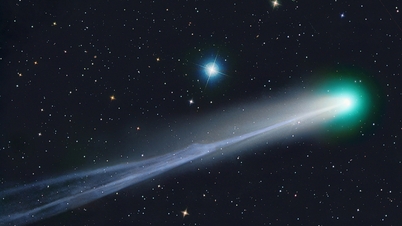The last nights of October promise to bring European astronomers a rare phenomenon, when three comets, Lemmon, Swan and 3I/ATLAS, appear in the sky together. Among them, 3I/ATLAS is a "visitor" from outside the Solar System, considered by scientists to be a precious message from distant space.
According to experts, the event of three comets appearing at the same time only happens about once every 10 years in the Northern Hemisphere.
Comet Lemmon, whose full name is C/2025 A6, was discovered in January at the Mount Lemmon Observatory in Arizona. After months of traveling, Lemmon is approaching its closest point to Earth, gradually brightening and becoming visible to the naked eye in dark conditions.
Through the lens of astronomers, this comet appeared with a blue tail extending more than 12 degrees, 25 times larger than the size of the Moon, creating a spectacular scene rarely seen with the naked eye.
The researchers say the distinctive blue color comes from ionized carbon monoxide, while the comet's head takes on a green hue due to the presence of C2 radicals.
At the same time, comet Swan (C/2025 R2), discovered by Ukrainian astronomer Vladimir Bezugly in September, is getting brighter as it approaches Earth.
The comet will be at its best viewing point on October 20 and 21, when it will be visible in binoculars as a faint dot of light in the southwest, in the constellation of the Eagle. Observers say the phenomenon can be seen more easily with no moonlight and less light pollution.
According to Professor Emmanuel Jehin, an astrophysicist at the University of Liège (Belgium), it is very rare for two comets to be visible to the naked eye in the same season, usually only happening once every 10 years.
He said both Lemmon and Swan fly quite close to the Sun, only about half the distance from Earth to the Sun, causing their activity to increase sharply and become more brilliant when reflecting light.
Not only stopping at two "regular guests" of the Solar System, the October sky also welcomes the appearance of comet 3I/ATLAS, the third interstellar object ever discovered, after 1I/Oumuamua and 2I/Borisov.
According to researcher Nicolas Biver, from the Institute of Astrophysics of the Paris Observatory (France), 3I/ATLAS is a special celestial body because it does not orbit the Sun but only passes through the Solar System once before continuing its journey into deep space. Initial analysis shows that this comet may have formed more than 10 billion years ago in an ancient region of the Milky Way.
Biver said 3I/ATLAS is like a “time capsule” containing chemical traces of the first star systems. Comparing its composition with comets in the Solar System will help scientists better understand whether the material that formed planets has properties common across the galaxy or differs according to each stage of evolution.
Scientists say 3I/ATLAS is moving at about 210,000 km/h and will only be visible to telescopes at the end of November.
The simultaneous appearance of three comets in the sky is considered a rare phenomenon, not only evoking the magical beauty of the universe but also reminding people of their smallness in the vast space, where each streak of light in the sky carries billions of years old stories of the Milky Way./.
Source: https://www.vietnamplus.vn/ky-thu-hien-tuong-hiem-gap-khi-3-sao-choi-cung-toa-sang-tren-bau-troi-post1071840.vnp



![[Photo] Prime Minister Pham Minh Chinh chairs meeting on nuclear power plant construction](https://vphoto.vietnam.vn/thumb/1200x675/vietnam/resource/IMAGE/2025/10/22/1761137852450_dsc-9299-jpg.webp)
![[Photo] Da Nang: Shock forces protect people's lives and property from natural disasters](https://vphoto.vietnam.vn/thumb/1200x675/vietnam/resource/IMAGE/2025/10/22/1761145662726_ndo_tr_z7144555003331-7912dd3d47479764c3df11043a705f22-3095-jpg.webp)


![[Photo] Award Ceremony of the Political Contest on Protecting the Party's Ideological Foundation](https://vphoto.vietnam.vn/thumb/1200x675/vietnam/resource/IMAGE/2025/10/22/1761151665557_giaia-jpg.webp)




![[INFOGRAPHIC] The impressive career of Japanese Prime Minister Sanae Takaichi](https://vphoto.vietnam.vn/thumb/402x226/vietnam/resource/IMAGE/2025/10/22/1761134856370_info-tanthutuong-nhatban-anh-thumb-jpg.webp)















![[Photo] General Secretary To Lam and his wife begin their official visit to Bulgaria](https://vphoto.vietnam.vn/thumb/1200x675/vietnam/resource/IMAGE/2025/10/23/1761174468226_tbtpn5-jpg.webp)
![[Photo] Comrade Nguyen Duy Ngoc visited and worked at SITRA Innovation Fund and ICEYE Space Technology Company](https://vphoto.vietnam.vn/thumb/1200x675/vietnam/resource/IMAGE/2025/10/23/1761174470916_dcngoc1-jpg.webp)












































































Comment (0)